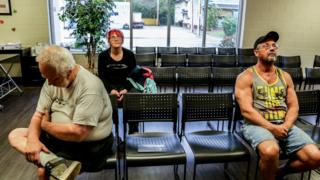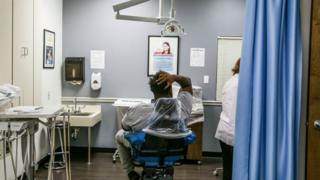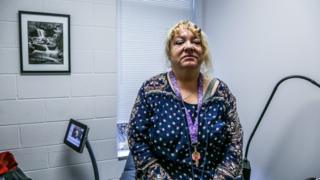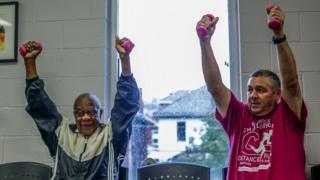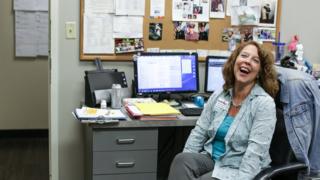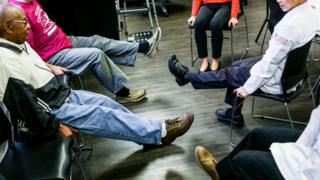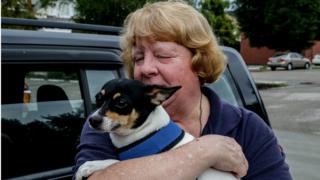The safety-net of US healthcare
West Virginia’s largest free clinic sits on a quiet street in Charleston, the small capital city of a state often called America’s unhealthiest. Since 1982, West Virginia Health Right has offered under- and un-insured patients access to healthcare at little to no cost.
“I think free and charitable clinics are the most overlooked jewel of the US,” says the clinic’s CEO, nurse practitioner Angie Settle.
Most legislation focuses on federally qualified health centres, Mrs Settle says, which receive federal funding to cater to lower-income and private patients alike.
“Well, we’re sitting right in the middle of two federally qualified health centres and we have 26,000 patients. So obviously they’re not meeting the whole need.”
Last year, West Virginia Health Right (WVHR) provided $15m (£11.6m) worth of healthcare and prescription medications to those patients – for an average per person cost of $115 (£90) for a full year of care.
“A lot of people have this misconception about free clinics that it’s just a handout for people who don’t want to work,” Mrs Settle says.
“That can’t be further from the truth. Eighty-three percent of our patients are employed in some capacity.”
But for many, having a job does not guarantee access to health insurance or care – and government assistance programmes have strict income limits.
“Without us, a lot of the people that we see would have no other alternative but to turn to public assistance, to quit their job so they can get poor enough to be on Medicaid.”
Bobbi Morrison, a nurse practitioner at WVHR, used to work in a private clinic, and says the difference is striking.
She could get insured patients there access to specialists in weeks. But for the uninsured or those on federal programmes?
“I’ve seen people wait for certain specialists six months to a year.”
At WVHR, physicians and dentists volunteer their time so that patients can get holistic treatment often in just one visit.
As a part of an initiative to build trust and keep patients on track with their care plans, new WVHR patients join one of three teams and will work with providers on those teams for as long as they come to the clinic.
Mrs Morrison says one of the clinic’s main goals is education.
“I have people come in all the time who haven’t had a women’s health visit in 20 years because they didn’t think they could get one anywhere.”
“What we take as basic common sense or understanding, a lot of people don’t have. That’s the hard part of what we try to do.”
Other voices on healthcare
The newly renovated second floor of the clinic boasts a large kitchen and teaching space for that very purpose.
And WVHR’s wellness classes are always packed.
Patients of all ages sign up for free lessons on healthy cooking, diabetes management, exercise – and then volunteer to lead classes themselves.
“It’s a support group. It’s a community,” clinical coordinator Rhonda Francis says.
“Our patients learn and then want to teach others.”
WVHR also teaches patients about couponing – using grocery deals to get healthier food – and offers challenges where patients can get cash rewards for losing weight.
“We’ve tried to add wrap-around services like behavioural health, addiction – making the health education more robust,” CEO Mrs Settle says.
She describes patients coming in like Nascar – car racing – drivers to pit stops: Providers try to squeeze every treatment in, “because we don’t know when we’ll see them again”.
Twenty-one-year-old Ricci Shannon says she heard about the free clinic from a co-worker after she mentioned suffering from a serious toothache.
Ms Shannon, who is uninsured, says she had been trying to avoid a trip to a dentist for fear of how much it would cost.
“It just seems expensive,” she says of health insurance. “An extra bill to incorporate when you’re just getting started.”
Margaret Grassie calls WVHR “a gift” to the community.
“I would literally be dead without this clinic,” the 57-year-old West Virginian says.
“If you got nothing, you still got something. You got a way to save your life, to get your insulin, your BP medicine, whatever you need.
“You hear people complain – ‘I’ve been sitting here for 20 minutes’ – well where in the hell else you gonna go? Where are you gonna get that prescription for nothing?”
Photographs by Hannah Long-Higgins. Reporting by Ritu Prasad.
.
Source: Read Full Article


